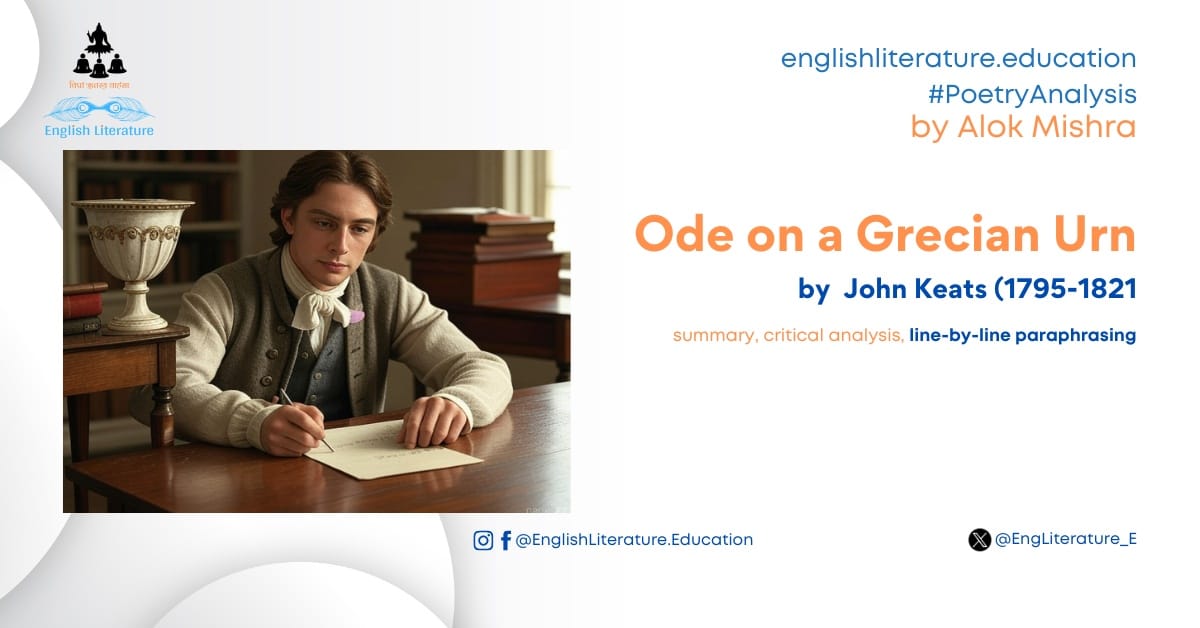Analysis of the Third Stanza from Ode on a Grecian Urn by John Keats
This stanza deepens Keats’s exploration of the urn’s portrayal of eternal beauty and love. The poet shifts his focus to the joy and vitality of the urn’s timeless imagery. By repeating “happy,” he celebrates the immortality of art, contrasting it with the ephemeral nature of human existence. However, the stanza also subtly hints at the limitations of such permanence, as it exists outside the flux of real life.
The Text:
Line-by-Line Explanation
- “Ah, happy, happy boughs! that cannot shed / Your leaves, nor ever bid the Spring adieu;”
- Keats marvels at the eternal spring depicted on the urn. The “boughs” remain perpetually in bloom, symbolising unchanging vitality and beauty. The trees are free from the natural cycles of decay, never having to experience the loss and barrenness of autumn. This eternal spring signifies a utopia unspoiled by time.
- “And, happy melodist, unwearied, / For ever piping songs for ever new;”
- The “happy melodist” (likely the musician playing the “soft pipes” from the previous stanza) is immortalised in the act of creation. Unlike human musicians, who tire or are constrained by the limitations of their craft, the melodist is “unwearied,” always producing fresh music. The phrase underscores the idealised nature of the art, where creativity is inexhaustible.
- “More happy love! more happy, happy love!”
- The repetition of “happy” underscores the abundance of joy in the timeless scene. The love depicted on the urn is “more happy” than mortal love because it is freed from the inevitable pain of loss, betrayal, or fading passion. The emphatic tone celebrates this state of eternal affection and desire.
- “For ever warm and still to be enjoy’d, / For ever panting, and for ever young;”
- The love between the figures on the urn remains forever in its most passionate phase. It is “warm,” representing the intensity of emotion, and “young,” untouched by the disillusionment or decay accompanying real-life relationships. The repetition of “for ever” reinforces the unchanging nature of this love, frozen in an ideal state.
- “All breathing human passion far above, / That leaves a heart high-sorrowful and cloy’d,”
- The love on the urn transcends the imperfections of human passion. While human experiences of desire often lead to disappointment, exhaustion, or emotional turmoil (“high-sorrowful and cloy’d”), the love depicted in art remains untainted. This contrast elevates the beauty of the urn’s portrayal of love but also introduces a note of melancholy, as it exists beyond human experience.
- “A burning forehead, and a parching tongue.”
- These physical symptoms of passion suggest that human desire is consuming and often destructive. In contrast to the serene and eternal love on the urn, real-life love can leave individuals drained and unfulfilled. This imagery highlights the imperfections of mortal experience, emphasising the perfection of the immortal scene on the urn.
Themes in the Third Stanza
- Permanence vs. Impermanence
- Keats contrasts the unchanging happiness of the urn’s imagery with the fleeting nature of human joy. The eternal spring and the everlasting love on the urn stand in stark opposition to the cycles of growth, decay, and renewal in real life.
- Idealisation of Love and Art
- The stanza portrays love and artistic representation as transcending the limitations of physical reality. The love on the urn is eternal, free from the complications and sorrows of genuine relationships.
- Human Passion vs. Artistic Perfection
- While human passion is intense and often overwhelming, it is also finite and prone to disappointment. The urn’s depiction of love, however, is eternally fulfilling and untouched by the flaws of real-life emotions.
Imagery and Symbolism
- “Happy boughs” and “eternal spring”
- Symbolise perpetual vitality, joy, and renewal, highlighting the timeless nature of the urn’s scene.
- “Unwearied melodist”
- Represents the boundless creativity of art, contrasting with the limitations of human effort and physical fatigue.
- “Burning forehead” and “parching tongue”
- Evoke the physical toll of human passion, symbolising the fleeting and often painful nature of mortal experiences.
Tone and Mood
- Tone
- Exuberant yet contemplative. While Keats celebrates the happiness and vitality of the urn’s imagery, there is an underlying tone of wistfulness as he reflects on the limitations of mortal existence.
- Mood
- The mood oscillates between celebratory and pensive. The reader is drawn to the beauty of eternal art while being reminded of the impermanence of human life and love.
Philosophical Reflection
In this stanza, Keats meditates on the dualities of life and art. The “happy, happy love” on the urn is an unattainable ideal—an eternally youthful and intense love that exists only in art. The poet’s reflection underscores the limitations of mortal existence, where love and passion, though profound, are accompanied by sorrow and impermanence. Yet, it also celebrates the power of art to preserve moments of beauty and emotion, offering a glimpse of perfection beyond the temporal world.
Concluding Remarks on the Stanza
This stanza encapsulates Keats’s Romantic ideals, where imagination and art are exalted as realms of perfection that transcend the imperfections of human life. Through his lyrical celebration of the urn’s eternal spring and enduring love, Keats invites readers to reflect on the paradox of permanence in art versus the transience of human experience. The balance of joy and melancholy makes this stanza a poignant meditation on the beauty and limits of life and art.
Navigation:
Stanza 1 – Stanza 2 – Stanza 3 (you are here) – Stanza 4 – Stanza 5
This article is a part of a series on Keats’ Ode on a Grecian Urn. You can read other articles by clicking the links below:
Ode on a Grecian Urn by John Keats: Summary & Critical Analysis
Figures of Speech, Poetic Devices in Ode on a Grecian Urn by John Keats
Prepared by A Mishra for ELE
…

